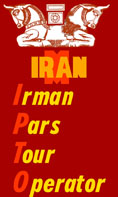|
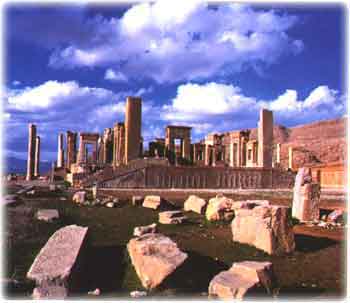 Dating hack to antiquity Fars province
has been a significant center of the Persian culture and civilization.
During some important Iranian dynasties, including the Achaemenids, Fars
was the capital of the country. Considering numerous historical monuments,
Fars is an exponent of the Iranian and Islamic art and history. Some of
the greatest Iranian poets and philosophers are from this province. The
identity of this province and the whole country is so much merged that
Iran was once known as Pars (Persian). Dating hack to antiquity Fars province
has been a significant center of the Persian culture and civilization.
During some important Iranian dynasties, including the Achaemenids, Fars
was the capital of the country. Considering numerous historical monuments,
Fars is an exponent of the Iranian and Islamic art and history. Some of
the greatest Iranian poets and philosophers are from this province. The
identity of this province and the whole country is so much merged that
Iran was once known as Pars (Persian).
Located in the southern Iran and
covering in art-a of 133000 square kms
Fars is bounded on the north by
Yazd and Isfahan on the west by Kohgiluyeh VA Boyer
Ahmad on the south
by Hormozgan, and Bushehr, and on he east by Kerman. The climate of Fars
is complex, ranging
From cold in the mountainous regions to warm in the
southern and eastern areas. The cities of Sepidan and Nurabad are located
in the mountainous regions. In the cities of Shiraz Kazerun Fasa and
Firuzabad the weather is mild, while Lar Khonj and Evaz have hot dry
summers.
The Zagros range stretches from the northwest to the
southeast. In the north and north-west of the province there are lofty
mountains like Barm Firuz andAzamat. The famous defile of Koli Kosh is in
this mountain. The mountains near Shiraz are Sabz Pushan, Kuh-e Bamu,
Kuh-e Tudaj and Khaman Kuh.
The most important river is Karkheh,
originating in the northern mountains, passing by the city of Marvdasht
and emptying into lake Bakhtegan.
This river across which the large dam
of Derudzan has been built irrigates many areas and creates spectacular
views. The dam is suitable for water sports. The other rivers of Fars most
of which flows into the Persian Gulf are as follows: Qara Aqaj, Shapur,
Dalki, Firuzabad and Fahlyan1. The waterfall or Margun in the westernmost
of Fars is very high, attracting large numbers of people.
There are
three impressive lakes in Fars: Bakhtegan (Neyriz), Parishan
(Famur)
And Maharul. Lake Bakhtegan in the eastern Fars is linked with
a smaller take called Teshk. Teshk is a shallow lake and is located in
Neyriz. Lake Bakhtegan is the habitat of some species of migratory birds.
Lake Bakhtegan situated in the southeast of kazerun, is a- center for
fishing and fish farming. There are recreational facilities on the lake.
Lake Maharul located 18 Kms east of Shiraz has salt-water from which salt
is obtained.
In the mountainous regions there are impressive caves the
most important of which arc as follows: Tadedevan cave, located 120 Kms
east of Shiraz on the road of jahrom-Shiraz this cave where a lot of bats
live, is one of the largest caves in Iran. Hedar Beyg, in which there is a
well, is located in Beyza.
Shafagh cave, located 140 Kms east of
Shiraz, Shah-e Qandab cave 45 Kms away from Abadeh And Kan-e Gohar cave 36
Kms away from Suryan in Abadeh are caves
Having eye-catching
stalactites andStalagmites. Shapur cave, 30 Kms from kazerun in which
there is a pool is a point of interest. A statue of Shapur I, king of the
Sasanian dynasty with a height of 7 meters in front of the cave.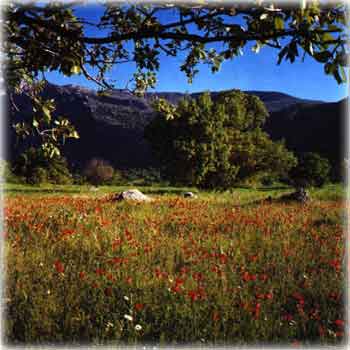
The vegetation of the province is rich in variety
including goat's thorn acanthus, milfoil, oak, almond and fig trees. The
forested areas are the stretches of the forests of the Zagros.
Wildlife
includes ibex gazelles, mouflon, deer, wild boars, foxes and jackles.
Birds found in the province are partridges, pheasants, eagles and some
species of migratory birds. The national park of Bamu in the northern
Shiraz covering an area of 40000 ha abounds with deer. Wildlife sanctuary
of Arjan, Established in the west Shiraz includes forests and many springs
a rare variety of Iranian deer lives in this area. Bahram-e Gur Harmad and
Bakhtegan are other wildlife sanctuaries
The ruling dynasty of the
Persian was settled in Fars by the Achaemenids. From then on Fars has been
a major center of the Iranian culture and civilization. Farsi is the
language, which is predominantly spoken. The religion of the majority of
the people is Islam. Religious traditions are of greatest significance in
the eyes of the people. The religious minorities are Zoroastrians, Jews
and Christians. One of the biggest Iranian tribes called Qashqayee lives
in Fars.
All cities of the Province are linked with each other and with
the neighboring provinces by asphalt all-weather roads. The International
airport of Shiraz connecting Shiraz with many cities in Iran and abroad
plays an important role in transportation of both passengers and goods.
The cities of Lar and Lamard also have airports linking then with Shiraz
and Tehran. Shiraz is on the main road From Tehran to The southern
Iran.
Agriculture is of grate importance in Fars. The major product
includes. Cereals (wheat and barley), citrus fruits, dates, sugar beets
and cotton.
The Fars's industries are of high significance, some of
which are the petrochemical industry, an oil refinery, a factory for
producing tyres, electronics industry and a sugar mill. Fars province
consists of 15 cities. Shiraz is the provincial capital and the
Others
are as follows: Abadeh, Estahban, Eqlid, jahrom, Darab, Sepidan Fasa
Firuzibad, Kazerun, Lar, Lamard, Marvdasht, Mamasani and Neyriz. Shiraz is
World-famous as a historical city.
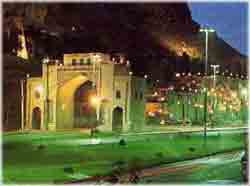 |
Located
at entrance of the city of Shiraz, the beautifully built Darvazeh
Qor'aan, was the place where two huge Qor'aan, know as the
Hefdah-man Qor'aan were kept. All who entered or left the city
had to pass through Darvazeh Qor'aan, thus passing underneath the
two Holy Qor'aan. Most Muslims believe that if a man walks on the
Holy Qor'aan before he sets out in a trip, he will safely return
home. The two Qurans are presently kept in the Pars Museum. |
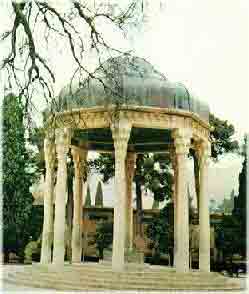 |
Hafezieh
is situated northeast of Shiraz, and is the grave-site of the
Persian, poet, Hafez, nicknamed "Lessan-ol-Gheib", and a place of
pilgrimage for his admirers. These admirers --Goethe, the
great German poet was one-- have flocked around his poetry,
pondering on its meanings. Despite the passage of centuries, Hafez's
poetry is as relevant today as
ever. | |
